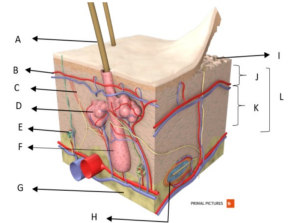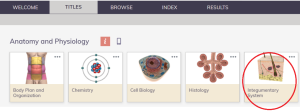






Name
Chamberlain University
BIOS-251 Anatomy & Physiology I
Prof. Name
Date
The skin has multiple layers, each serving distinct functions. Below is a table outlining the structure and corresponding function of each layer.
| Structure | Function |
|---|---|
| Stratum Corneum | Acts as the primary barrier between the body and the environment. |
| Stratum Granulosum | Forms a waterproof barrier to prevent fluid loss. |
| Stratum Spinosum | Contributes to the skin’s strength and flexibility. |
| Stratum Basale | Responsible for the proliferation and attachment of the epidermis to the dermis. |
| Basement Membrane | Forms an anatomical barrier, relays important signals, and contributes to tissue differentiation and maintenance. |
| Sensory Neuron | Transmits impulses from receptors like the eye, ear, spinal cord, or brain. |
| Dermis | Cushions the body from stress and provides elasticity to the skin. |
| Langerhans Cell | Migrates from the epidermis to lymph nodes, aiding in immune responses. |
| Merkel Cell | Involved in neural encoding of light touch stimuli. |
| Keratinocyte | Produces keratin, arises from the stratum basale, and undergoes continuous mitosis. |
| Melanocyte | Produces melanin, the pigment responsible for skin color. |
The gross anatomy of the skin consists of various structures that play key roles in protection, sensation, and thermoregulation. Below is a table listing these structures and their functions.

| Structure | Function |
|---|---|
| Hair | Provides protection, regulates body temperature, and facilitates evaporation. |
| Cutaneous Blood Vessel | Transports oxygen and nutrients to the skin while removing waste products. |
| Arrector Pili Muscle | Contracts to make hair stand, a response to cold or emotional stimuli. |
| Sebaceous Gland | Produces and secretes sebum, which lubricates the skin and protects against friction. |
| Merocrine Sweat Gland | Secretes sweat, which cools the skin and reduces body temperature. |
| Hair Follicle | The cavity or sac from which hair originates. |
| Hypodermis | Composed of connective tissue; aids in support, thermoregulation, and stores energy. |
| Pacinian Corpuscle | A receptor for pressure and vibration, located at the end of a sensory nerve. |
| Epidermis | Provides a waterproof barrier and creates skin tone, regulating body temperature. |
| Papillary Region | Provides nutrients necessary for the production of keratinocytes. |
| Reticular Region | Contributes to the skin’s strength and elasticity. |
| Dermis | Cushions the body from stress and strain. |

Homeostatic Regulatory Mechanism Components:
Physiological Events During Thermoregulation:
Thermoregulation is a form of negative feedback that helps maintain homeostasis. When the body temperature drops, shivering occurs due to muscle contractions that generate heat. This process helps to raise the body’s temperature back to normal levels. Conversely, when the body overheats, sweating helps to cool the body through the evaporation of sweat on the skin.
Condition Due to Increased Body Temperature:
Hyperthermia is the condition that occurs when the body’s heat-regulating mechanisms are overwhelmed, leading to an excessive rise in internal temperature.
Comparison of Epidermal and Dermal Wound Healing:
Epidermal wound healing occurs when the epidermis is affected. This process is quicker and involves only the superficial layer of the skin. On the other hand, dermal wound healing, also known as deep wound healing, involves the dermis and takes longer due to the involvement of deeper skin layers.
First Step in Wound Healing and its Significance:
The first step in wound healing is hemostasis, which begins immediately after an injury. This process is critical as it stops the bleeding through vasoconstriction and the formation of blood clots.
Importance of Inflammation in Wound Healing:
Inflammation is crucial because it controls bleeding and prevents infection. This stage involves the influx of leukocytes to the wound, which help to remove damaged cells, pathogens, and bacteria.
Fibrosis in Deep Wound Healing:
Fibrosis occurs during deep wound healing when the injured tissue is replaced by scar tissue, resulting in the restoration of the tissue’s structure and function.

Jane suffered partial thickness burns to the anterior region of her legs.
Definition of Partial Thickness Burns:
Partial thickness burns, also known as second-degree burns, involve the epidermis and part of the dermis. These burns are characterized by redness, blistering, swelling, and pain.
Loss of Sensation:
Jane likely lost sensation in the affected area due to nerve damage, a common consequence of second-degree burns.
Burned Body Surface Area Calculation:
According to the Rule of Nines, Jane’s burns cover 36% of her total body surface area.
Tom fell into a frozen pond, leading to signs of hypothermia.
Definition of Hypothermia:
Hypothermia occurs when the body loses heat faster than it can generate it, causing a dangerously low body temperature, typically below 95°F (35°C).
Skin Receptors Detecting Temperature Decrease:
Thermoreceptors in the skin detect the decrease in temperature.
Control Center Monitoring Signals:
The hypothalamus acts as the control center, monitoring signals from thermoreceptors.
Blood Vessel Response During Hypothermia:
Blood vessels undergo vasoconstriction, reducing blood flow to the skin to preserve core body heat.
Hair Response:
Tom’s body hair stands on end (piloerection) to create an insulating layer of warm air.
Feedback Mechanism:
Negative feedback will restore Tom’s body temperature to its normal state, bringing the body back into equilibrium.